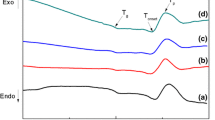Abstract
Soluble glass is synthesized using sodium sulfate. Decorative glass ceramic materials are made on its basis. This paper considers the results of x-ray phase analysis and thermodynamic calculations of the redox reactions of sodium sulfite formation, as well as data on physicomechanical and color testing of the produced composite materials.
Similar content being viewed by others
References
V. I. Babushkin, G. M. Matveev, and O. P. Mchedlov-Petrosyan,Thermodynamics of Silicates [in Russian], Stroiizdat, Moscow (1986).
M. Kh. Karapet’yants,Main Thermodynamic Constants of Inorganic and Organic Materials [in Russian], Khimiya, Moscow (1968).
Author information
Authors and Affiliations
Additional information
Translated from Steklo i Keramika, No. 9, pp. 10–13, September, 1999.
Rights and permissions
About this article
Cite this article
Gaidzhurov, P.P., Tkachev, A.G. & Tamazov, M.V. Specifics of synthesis of soluble glass using sodium sulfate. Glass Ceram 56, 275–278 (1999). https://doi.org/10.1007/BF02681374
Issue Date:
DOI: https://doi.org/10.1007/BF02681374




